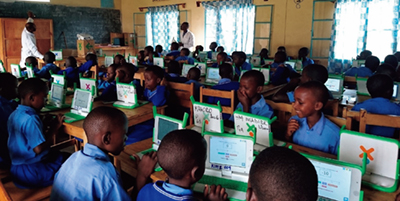Master Techniques from Japan to the World 2
Japanese Software Dramatically Changing Primary Mathematics Education at Elementary Schools
An SME initiative in Rwanda, which aims to become an ICT leader

A screenshot of the mathematics software developed for Rwanda (Photo: SAKURA-SHA)

Children enjoying a class, using the mathematics software developed by SAKURA-SHA (Photo: SAKURA-SHA)
Since the inauguration of President Kagame in 2000, Rwanda has aimed to become a leader in the information and communication technology (ICT) field and has focused on the increased use of ICT and human resources development. However, due to several reasons, including a low mathematics proficiency level in primary education as well as factors such as a lack of available educational software, Rwanda faced difficulty in utilizing ICT in educational settings. In response to this situation, SAKURA-SHA K.K., a company with its headquarters in Tokyo that develops and sells mathematics software for elementary schools in Japan, has been conducting a verification project to introduce its original mathematics software in elementary schools in Rwanda since October 2018 through JICA’s SDGs Business Supporting Surveys for SMEs framework.
During his visit to Rwanda for the purpose of designing and developing software for the country, Mr. YOKOYAMA Kenya, President and Chief Executive Officer of the Japanese company, saw children struggling with even simple calculations. The children seemed to have difficulty in performing simple mental arithmetic calculations, because even to answer an addition such as “3+4,” they would draw as many circles as the numbers in the formula, and then count the number of circles to answer the question. In addition, the students did not have their own textbooks, and during class, they seemed to quietly listen to teachers giving non-interactive lectures from a platform. Mr. Yokoyama saw this situation and felt that his company could potentially contribute to improving the quality of education in Rwanda by introducing mathematics software developed by SAKURA-SHA.
Another reason that encouraged the implementation of this project was the high distribution rate of computers in Rwandan elementary schools. As part of a national policy to strongly promote ICT, computer terminals themselves were widely distributed, and most elementary schools in Rwanda had computers for student use. However, those computers were rarely utilized in many schools because educational software had not been developed. Mr. Yokoyama thought that if his company’s mathematics software could be provided, it might help utilize those unutilized computers and offer a new education style that makes learning fun for the children.
However, there were various challenges in developing mathematics software for Rwanda. Firstly, the company had to build a new software from scratch, because it was not possible to use the programs utilized for software in Japan due to the difference of specifications between the computers used in the elementary schools in Rwanda and those that are generally used in Japan. The second challenge was the language. In order to develop software that conforms to the contents of Rwandan textbooks, it was necessary to understand all of the textbooks written in Kinyarwanda. Mr. Yokoyama, with his long teaching experience as a former elementary school teacher as well as work experience in developing teaching materials in Japan, took approximately one year to comprehend the textbooks himself and then supervised the software development work. Mr. Yokoyama tells us the points that the software development team paid particular attention to when developing the software were as follows:
“If you are just translating the contents of the software, excluding mathematical formulas, that have been developed for Japanese schools from Japanese into Kinyarwanda, it is relatively easy to develop the software. However, we thought that it would be difficult for the local schools to accept such software as it would not conform with Rwandan textbooks and curriculum. Therefore, we studied Rwandan textbooks thoroughly and developed software contents in line with their teaching style. We also incorporated creative ideas to make the software fun to use for local children; for example, we changed an icon that children operate when launching the software from a ninja in Japan to a gorilla in Rwanda.”
The mathematics software for Rwanda was completed thorough the abovementioned process. The next concern was whether Rwandan teachers, who were used to providing non-interactive lectures and not accustomed to interactive instructions, would accept the new lesson method using the software. However, their teaching style improved after the teachers actually tried out the software and experienced its fun aspects, which can be operated like a game.
Ms. MACHIDA Mariko of SAKURA-SHA notes, “In actual classes, I saw teachers walking around the classroom, using the software with students and giving them advice at their desks, which was previously unthinkable in the lesson style in Rwanda.”
The reactions of the students during class were also wonderful. As characters move and make sounds when the software is operated, Rwandan students, who until then did not have textbooks and sometimes just stayed seated without understanding the lectures, would now actively attend classes, talking with their teachers with a smile. As a result, there were major achievements, such as a dramatic improvement in academic performance at all schools that introduced the software on a trial basis. Even more, one class reported a surge in the rate of questions answered correctly from 12.6% to 64.3% after a week of intensive lessons using the software.
Mr. Yokoyama shares with us his following future goals.
“By 2021, we plan to introduce the mathematics software on a trial basis in more elementary schools in Rwanda to verify its learning effect. Introduction of the software has received positive responses from the Rwanda Education Board and school educators, with an elementary school using the software having been selected as a candidate to receive a visit by the President of the country. We will continue to cooperate with stakeholders in Rwanda and ultimately aim to bring the mathematics software to all public elementary schools in the country.”
Initiatives are steadily advancing in Rwanda, where contents from Japan are transforming mathematics education, which, in turn, bring about positive changes to the future of the children and also to the country itself.
<< Previous Page Next Page >>
Main Text | Reference Statistics | Stories from the Field | Master Techniques from Japan to the World | ODA Topics
